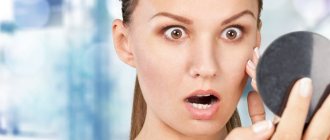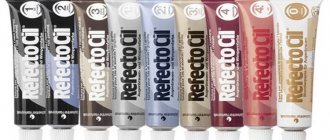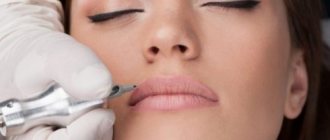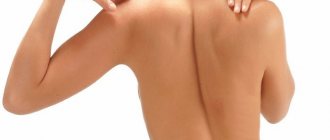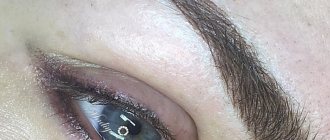Eyebrows determine a girl's appearance. Changing their thickness and color affects perception. Bright and painted shapes have fallen out of favor. The natural look has become fashionable. A new procedure has been developed especially for those with sparse hair – eyebrow microblading.
Microblading is a technique of applying pigment to the eyebrow area.
General concept of eyebrow microblading
This is a technique for shaping eyebrows that makes them look like your own for a long time. Some people call the procedure manual permanent makeup. It differs from hardware in technology and the result obtained. Microblading does not apply an even color to the skin. Specialists make small incisions, and through them the desired area is filled with pigment. They look like hairs, so they seem natural.
Artists from all over the world have been doing microblading for about 10 years. The origins of technology come from China. At first, the technology was intended only for Asians and was different from modern technology. Later, microblading became popular among Europeans. Its founders in Russia were Natalya Krasnoperova and Irina Levchuk.
Indications for the procedure
Girls get microblading for a variety of reasons.
Main indications:
- different eyebrow shapes;
- dissatisfaction with their density, color;
- partial absence of hairs, scars.
Girls do microblading for different eyebrow shapes.
For some, hairs may be completely absent (for example, after chemotherapy).
Main advantages
Using a special device, the master makes small incisions on the skin. As a result, the client receives eyebrows without traces of coloring.
Microblading has many advantages, including the following:
- registration does not take much time;
- the procedure is done with a thin needle and does not cause pain;
- the risk of injury is minimized;
- the skin is quickly renewed;
- You can achieve the desired result after 1 time;
- the technology does not leave swelling.
Having done microblading, you can forget about makeup for a long time.
What is the difference between microblading and regular tattooing?
As we know, this procedure appeared relatively recently. It's no wonder that many women wonder what it is - eyebrow microblading? How long does it last? Are there any positive reviews? To answer all these questions, you must first understand the technique of performing it, and also understand how it differs from regular tattooing. As a rule, the latter is performed using a special machine, which allows you to inject pigment under the skin through several punctures at once.
With microblading, all manipulations are carried out manually. The pigment is injected under the skin using a special device - a manipulator. This way the master can control all his movements and perform precise, almost jewelry-like work.
Let's take a closer look at the differences between conventional tattooing and microblading techniques:
- Introduction of pigment to different depths. With tattooing it is 1–2 mm, with microblading – 0.2–0.5 mm.
- The differences are in the final appearance of the eyebrows. Due to deep penetration under the skin during tattooing, the pigment lightens by 30–50% of the initial shade, with microblading - only by 20%.
- Saving the effect. With tattooing, a repeat procedure will be required after 5 years, with microblading – after 2 years. This is directly related to the depth of the introduced pigment.
- Naturalness. As a rule, microblading is carried out pointwise, the master draws each hair, which allows the eyebrows to look as natural as possible. After the tattoo procedure they look a little unnatural.
- Painful sensations. Since the master works at a shallow depth during microblading, discomfort during the procedure is minimized. Therefore, girls with hypersensitive skin should pay attention to this service.
Execution techniques
There are several techniques for applying permanent makeup. Every girl will be able to choose the right one for herself.
Voloskovaya
The master draws individual hairs. This technique is suitable for changing shape and painting empty areas.
The hair technique is suitable for changing the shape of the eyebrows.
Shadow
Light shading is done: the lines that replace hairs are applied indistinctly.
Powder eyebrows
The pigment is shaded in such a way that it gives the impression that the eyebrows are painted with shadows. The strokes that replace the hairs are almost invisible. This type of microblading is suitable for fair-haired girls.
Powder eyebrows are a new permanent coloring technique.
6D
The procedure allows the specialist to apply fine lines to the skin.
European
The master draws lines of the same size. They all look in the same direction. As a result, emphasized eyebrows look well-groomed.
European microblading technology allows you to get thick eyebrows.
Eastern
The master applies strokes of different lengths and directions. Creates a light volume effect.
Rules for choosing a good master
Choosing a master is the most important step. His skills influence the final result. You shouldn't trust the first one you come across.
Portfolio
It speaks of experience and skill. The more examples of work in your portfolio, the lower the risk of getting hired by a non-professional. It is also worth paying attention to whether it contains photographs of work a month after the procedure. They allow you to evaluate the quality of the service.
The portfolio speaks about the experience of the master.
Reviews
In order not to make a mistake in choosing a specialist, it is recommended to read reviews about his work. You can find them on your personal website or on social networks.
If you have any doubts, you can write to past clients of the master. They will have the answer to all your questions.
Diplomas and certificates
Good specialists undergo training. Upon completion, each of them receives a document confirming their level of qualification.
Good specialists have certificates.
Service cost
If a master charges too little for his services, you should think about his level of qualifications. Microblading doesn't have to be cheap.
Compliance with sanitary standards
When entering the office, the first thing you need to pay attention to is order. In addition, it is worth asking how instruments are sterilized.
Why does safe microblading have contraindications?
Microblading (eyebrow embroidery) is a relatively safe and low-traumatic procedure. It is associated with two factors leading to contraindications:
- introduction of a foreign substance (pigment) into the skin;
- by applying, albeit micro-, but still incisions (that is, with trauma to the skin).
The dye may become an allergen. Modern pigments, especially high-quality ones, are hypoallergenic and designed to be introduced into the deep layers of the skin, but the risk of individual intolerance remains.
A microcut of the skin is carried out with trauma to 1-2 layers of skin and damage to collagen fibers, so it heals with a scar. This is a very thin scar, invisible to the eye, but if you have a tendency to form rough scars (keloids), instead of beautiful, graceful eyebrows, you will get an ugly scar. Microblading is not suitable for this type of pathology.
Cutting tissue leads to bleeding. And if you have hemophilia, any microcut bleeds for a very long time. What about a large number of microcuts, what do you think? In addition, the pigment is washed away with the blood and the procedure becomes useless.
The pigment does not take root well during hormonal riots, hence the recommendation to abandon the procedure during pregnancy and lactation, serious problems with the level of sex hormones in the blood and during menstruation. Taking antibacterial agents reduces the survival rate of dyes.
If there is an infection in the blood, the procedure is also not performed. By injuring the skin, you risk causing an inflammatory process in the area close to the eye, and this is not only unpleasant, but also dangerous.
It is also dangerous to undergo tattooing if you have epilepsy. Think for yourself what could happen if a convulsive attack begins literally “under the blade” of a master working on your face.
Why is microblading taboo for women with mental disorders? Because not a single psychiatrist guarantees that a person with a fragile psyche will adequately perceive a master with a manipulator.
Remember, you cannot hide your condition from a specialist! This is your face and your health. Don't let the master down and don't sacrifice your health to beauty.
If you tell a specialist that you have medical contraindications to permanent eyebrow makeup, and he undertakes to “embroider” your eyebrows, think about his qualifications and the conscientiousness of the specialist.
Preparatory activities and compliance with recommendations
The shape and color are chosen by the master together with the client.
The following color options are recommended:
- Blondes – gray or brown tones.
- Red – dark brown and copper.
- For brunettes – gray-black and brown.
Brown eyebrows suit blondes.
Professionals suggest tones slightly darker than the chosen one. This is done because after healing the color becomes less saturated.
In addition, the shade fades over time. The brighter it is initially, the longer it will last. After choosing a color, you need to prepare for the microblading itself.
Before applying the pigment it is recommended:
- Do not take antibiotics: they prevent the paint from taking root.
- Avoid alcohol: it thins the blood. This leads to a deterioration in the final result.
- Refrain from visiting the solarium. Ultraviolet rays make the skin rougher, so the shade may apply unevenly.
- Do not pluck hairs. The specialist will make the correction himself.
- Don't drink coffee.
All advice is important. An experienced specialist will certainly remind you of them.
How the procedure is performed: main stages and duration
Microblading includes several stages.
Expert consultation
The master tells his clients all the details. The girls look at examples of work, ask questions about pain, results and duration of the effect.
The master can tell you about the result.
Creating a Sketch
A sketch of the new form is made with a special pencil. Taking into account the volume and density, each hair is drawn. The sketch is discussed with the client and adjusted if necessary. The work will be carried out until the desired result is achieved. At the same stage, the paint color is selected.
After this, a final sketch is created, which will later be recreated.
Anesthesia
Although microblading is painless, artists still use painkillers. They are applied around the eyebrow and the client begins to feel numbness in this area. To reduce discomfort, it is recommended to apply the product both before and during the procedure.
Experts use painkillers.
Performing microblading
After the painkiller has taken effect, the pigment is applied. Each hair is drawn out carefully and in exact accordance with the sketch.
At the end of the procedure, the master talks about how to care for your eyebrows after microblading.
Benefits, contraindications and duration of results
1. Microblading of eyebrows (reviews from clients fully confirm this fact) is a real godsend for those whose eyebrows have a pale tint, in some areas there are no hairs or a distorted shape.
2. Compared to classic tattooing, microblading takes less time and guarantees minimal pain. This method is suitable even for those with hypersensitive skin.
3. Eyebrows look beautiful and natural after the procedure.
4. Thanks to thin needles, the skin is less injured and swelling does not occur.
5. No scars. Even if you had to undergo the microblading procedure several times, you will not encounter this problem.
6. The master carefully selects the pigment color based on skin tone, original eyebrow color and current hair shade. But, like classic eyebrow tattooing, the microblading procedure does not give you any guarantees of using black pigment. This means that the final color will have a slightly grayish tint.
7. Correction is only possible for people with different skin characteristics. Over time, the pigment will not acquire a purple or green tint. It will wash out naturally.
Contraindications:
1. It is not advisable to undergo microblading during menstruation and pregnancy.
2. The appearance of unknown formations in the eyebrow area.
3. Colds.
4. Mental disorders.
5. Diabetes mellitus.
6. Epilepsy.
7. People with poor blood clotting and related diseases.
8. Severe degree of somatic diseases.
9. Increased possibility of colloidal scars.
It’s impossible not to answer one of the frequently asked questions: “How long does eyebrow microblading last?” Feedback from women on this matter is different. Some say that the beauty lasted for a year, others claim that it was 1.5. But experts say that it all depends on the skin, or more precisely, on its age and metabolism. From here we conclude: the older the client, the slower the pigment will be removed.
Proper eyebrow care after: prohibitions and restrictions
Eyebrows heal within a week after microblading.
Care instructions:
- During the first 24 hours, eyebrows should not be wetted or touched with hands. There may be slight swelling near the application area, which will subside the next day.
- For a week you will have to give up going to the beach, solarium, or sauna. The same rule applies to decorative cosmetics.
- It is better not to peel in the next 14 days.
- If a crust appears, it should not be wetted or torn off. It will dry out and fall off on its own.
You can fully evaluate how the pigment has settled after healing - in a month.
Care products
In order for the results to last for 2 years, you need to carefully care for your eyebrows. Immediately after the procedure, the master applies a healing ointment to the skin. It does not need to be removed within 3 hours. Afterwards you can wash your face with warm water and foam or gel. You can’t dry yourself with a towel; it’s better to blot your face with a napkin.
Healing ointment should be applied to the eyebrows.
To get rid of pain and swelling, Vaseline is applied the first day after washing. This must be done at least 3 times.
The next day, you can wash your face with your usual product, but you must continue to smear your skin with Vaseline. This is done until the crust completely falls off, on average 9 days.
After microblading, small wounds form. To avoid inflammation, it is recommended to wipe them with a chlorhexidine solution. If this is not done, the crust may pull out the pigment and there will be no result. After 3 days, the color becomes bright and the peeling process begins.
The affected area must be constantly moistened. A suitable remedy is Bepanten cream. It is applied to the eyebrows at the first sign of dryness.
Additionally, you can make a mask from an infusion of mint or chamomile with linseed oil. Herbs soothe the skin and promote its restoration.
Preparing for microblading
Getting a good result depends not only on the master, but also on the person himself. It is necessary to follow the instructions to avoid possible unpleasant consequences.
Self-preparation is simple:
- For two weeks before microblading, you cannot remove excess hairs using tweezers or wax strips, as the master will do this himself during the operation. Also, at this time, you should not dye your hair with strong dyes. Daily touching up with pencil or eye shadow is permitted.
- For a week you cannot visit the solarium and bathhouse, or stay in the open rays of the sun for a long time; limit the entry of foreign bodies into the body: antibiotics, painkillers.
- For 2-3 days, reduce the consumption of alcoholic drinks, as well as energy drinks.
- You should not drink strong black tea or coffee 24 hours before. They affect changes in the diameter of blood vessels, which is why the result of the procedure may not be complete.
There is also no need to schedule microblading during menstruation or before going on vacation to warm countries. Since for a couple of days after it, it is not recommended to stay in the sun a lot, or swim in salty water sources.
If you are sick, reschedule eyebrow microblading to any other time, as an infection in the body can negatively affect the result. There are also two moral signs: the master will not be comfortable being in a room with a sick person; A long procedure will cause you a lot of harm and inconvenience.
Duration of effect
The effect lasts 1.5-2 years. The exact period depends on the characteristics of the leather and the quality of the materials used. After this time, the pattern begins to lighten and disappear.
The duration of the effect depends on the characteristics of the skin.
The first correction is done in a month. By this time, the eyebrows have completely healed and the pigment is fully visible. The specialist will clearly see in which places the drawing needs to be corrected. In the next few months, 1 more correction may be needed.
The procedure can be repeated after a year, without waiting for the pigment to disappear completely.
How often do microblading touch-ups?
In order for the effect of eyebrow microblading to last as long as possible, it is recommended to make corrections regularly. It is advisable to come back for an appointment with a cosmetologist after the skin has completely healed and recovered - about a month after the procedure.
If you do not resort to correction, the following consequences may occur:
- the contours of the lines will become fuzzy;
- the pigment will become discolored;
- the tone will become uneven.
With timely eyebrow correction, you will not often have to do a full-fledged microblading procedure, which will have a positive impact on your budget.
Comparison with alternative techniques
There are different ways to create beautiful eyebrows. Differences can be traced in almost everything: in the pigments used, the depth of their introduction and the technique of execution.
Tattoo
For tattooing, a chemical pigment is used, which is injected to a depth of 0.8 mm to 1.5 mm. During the procedure, girls experience severe pain. The effect lasts for more than 3 years. Depending on the characteristics of the skin, it can remain for life. Tattooing severely injures the skin because the needle is inserted too deeply.
The tattoo is injected deep into the skin.
Nanospraying
This is one of the safest techniques. The difference between it and microblading is that not small incisions are made on the skin, but small dots. After complete healing, it appears as if the eyebrows were painted with shadows or a pencil.
Permanent makeup
Permanent makeup allows you to create a pattern of the desired size and color on the skin. This can be achieved by introducing dye into the upper layer of the skin. The procedure is carried out using a special machine with a hollow needle. Its disadvantage is that if the device fails, the eyebrow may turn out uneven.
What is microblading
Eyebrow Microblading: Pros and Cons
The eyebrow microblading technique is sometimes called manual permanent makeup. It is aimed at improving the appearance of eyebrows, without compromising their naturalness. Small, shallow incisions are made on the skin under the hairs, into which the dye is injected. This creates the effect of hairs, making the eyebrows look more natural than when using another similar technique - tattooing.
Microblading result
List of indications for microblading:
- Too thin, over-plucked eyebrows;
- Thin, sparse hairs;
- Natural asymmetry or the consequences of careless plucking;
- The presence of areas where hairs are missing (for such cases, partial microblading is sometimes requested).
The result of the procedure remains lasting from 7 months to 1.5 years. The exact figure depends on the individual characteristics of the skin.
Main contraindications
Before doing microblading, you need to familiarize yourself with the contraindications.
The procedure is prohibited if:
- diabetes mellitus;
- damage to the skin near the eyebrows (microblading can be done after it has completely healed);
- elevated temperature;
- poor blood clotting;
- diseases transmitted through blood (hepatitis, HIV, syphilis, herpes);
- allergies to paint.
The procedure is prohibited if you have diabetes.
To find out if you have an allergy, you need to do a test. Pigment is applied to the skin. If you experience unpleasant sensations, you will have to refuse microblading.
Negative aspects of microblading
Despite the benefits, microblading also has its downsides.
These include:
- there are many contraindications;
- without the use of anesthesia, the procedure will seem painful;
- You will still have to take care of your eyebrows - moisturize, pluck out excess hairs and make corrections;
- the first days after the procedure you need to limit your activity;
- the cost of the procedure is high;
- if you don’t like the result, it won’t be easy to get rid of it;
- your hair may be damaged.
There is nothing complicated in the procedure, and the result obtained cannot but rejoice. The main thing is to properly care for the treated area.
Timing of correction
Girls who decide to have 6-D eyebrow embroidery (microblading, microblading) ask how many days later to do the correction? The corrective procedure is carried out strictly within 30-45 days after the main manipulation.
This has nothing to do with recovery time. The tissues heal within 7-10 days. The pigment finally takes on color after a month. Then the final result is visible, and the specialist understands what needs to be corrected. Why fix it? Read on.
Reviews from girls about the procedure
Alena, 30 years old, Nizhny Novgorod: “The first three days after the procedure were terrible. I constantly have to smear my eyebrows with Vaseline. If possible, it is better to do microblading before the weekend. Otherwise, the result meets expectations.”
Tatyana, 28 years old, Vladimir: “The first thing to do is to take a responsible approach to choosing a master. If the specialist is good, the procedure will not leave any scars.”
Irina, 23 years old, Moscow: “Microblading is a gentle procedure. The paint is made from natural materials, so you don’t have to worry about side effects. With proper care, neat eyebrows will delight you for a long time.”
